Thom Ollig writes a detailed tactical analysis about the Premier League match that ended Watford 1-1 Crystal Palace.
Mazzari’s Watford welcomed Crystal Palace and their new manager Sam Allardyce or “Big Sam” as many choose to call him, to Vicarage Road. This was a game with lots of differences between the two teams. The continuously imposing multinational Watford with Mazzari and his Italian-inspired football, against Crystal Palace and their more British-inspired squad and football philosophy with the nowadays coach Sam Allardyce at the forefront.
Due to the fact that Crystal Palace have just gotten a new spark in their new manager Sam Allardyce, many people expected a tight game although Crystal Palace saw themselves just outside the relegation zone.
Line Ups:

Made using TacticalPad
Watford (3-5-2): 1. Gomes – 4. Kaboul 5. Prödl 3. Britos – 7. Amrabat 22. Janmaat 29. Capoue 18. Guédioura 25. Holebas – 11. Behrami 24. Ighalo
Crystal Palace (4-2-3-1): 13. Hennessey – 34. Kelly 6. Dann 27. Delaney 2. Ward – 4. Flamini 42. Puncheon – 10. Townsend 7. Cabaye 11. Zaha – 17. Benteke
Watford’s 3-5-2 defensively
Watford’s 3-5-2 is a very direct tactic, with lots of compactness in the middle of the pitch. Although the 3-5-2 can be used as an offensive formation it is today mostly used as a defensive tactic, due to the fact that it gives your team the possibility to overload almost any horizontal space in the pitch defensively, and at the same time with your two strikers get great opportunities to create direct counter attacks. If you instead push up your team to the opponent’s half of the pitch and have the players further from each other in an attacking formation, then the numeral disadvantage on the flanks becomes visible.
Because of the manager swap, Mazzarri were unsure of how Sam Allardyce would form his side. All he had to expect was a glowing Crystal Palace, a Crystal Palace who many thought would take the command right away with lots of energy due to the manager swap. The former midfielder therefore formed a defensive tactic with great counter-conditions, and therefore continued in his 3-5-2.
3-5-2 is a very flexible formation when it comes to defending. As I mentioned before it gives your team the opportunity to overload almost any horizontal space in the pitch, as long as the players stay compact. When Watford are sticking this compact on their half of the pitch, the only way to open up space and create something against them is either to cross the ball up vertically, or play the ball sideways. Since most teams want to play along the ground, Watford force them to play it on the flanks. When Watford’s opponents then do so, Watford are able to make the necessary rotations and lure their opponents into pressure traps. As for this game, when Crystal Palace played along the flanks on the playing surface with their numerical advantage as Watford only had their wingers, the nearest center back supported the winger along with the nearest central midfielder. Due to this overload Watford had as many, or even sometimes more players on the flanks than Crystal Palace.
When then the center back then overloaded the flank, the other two were forced to follow him, which sometimes created space on the other flank. To prevent Crystal Palace from exploiting that other flank, the other winger of Watford tended to sink deeper and close that space. This rotation along with Ighalo and Deeney closing down the opportunity to pass the ball backwards, created pressure trap many times under the game.
Here below you see a complete example of how it looked like when Watford lured Crystal Palace into pressing traps.
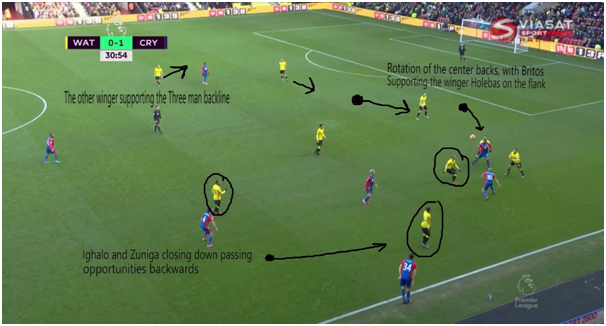
Watford’s 3-5-2 offensively
When it comes to the offensive part, it was a little bit less complex. Watford’s 3-5-2 has proved to be anything but a possession based tactic, as they want to be the team sitting down and defending. Therefore Watford play very direct straight up the pitch rather than passing it along the ground sideways. Before Crystal Palace took the lead, Watford’s only way of attacking was by playing the ball directly up the pitch, pointed at their two strikers or in some rare cases their wingers. Even when Crystal Palace laid back and let Watford have the possession they played it undoubtedly directly up the pitch. With that mentioned, Watford wanted Crystal Palace to have the majority of the possession, and hit on the counter when Crystal Palace were unstructured in their positioning.
When Watford have the lead or sometimes even when the game is even, this works very well, since Watford’s two strikers get very isolated up top with their opponents’ center backs, who sooner or later probably will be unable to stop them.
When Watford instead don’t have the lead, this plan gets more difficult to exploit, since the center backs of the opponent’s side tend to get better support from the midfielders when they lose the ball. This is what happened this game, and is a proof that this tactic is better adapted defensively, rather than offensively.
Below is an example of how Watford attacked very riskily and what caused them to give up possession, but also how occupied the Crystal Palace center backs were by Watford’s strikers.
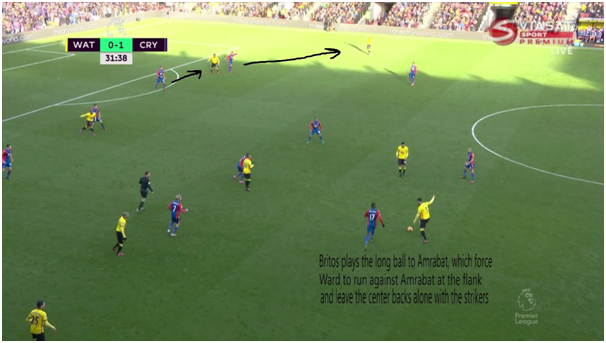
How Sam Allardyce countered Walter Mazzarri
There are two ways to counter a team that plays with three center backs. The first way
is for those who want to take initiative and dominate on the pitch. That is to play with a three-man back line against it. First of all it gives you the opportunity to attack without being especially worried when it comes to the defending part, mainly due to the fact that you have a numerical advantage against their two strikers with your three center backs. Second of all it prevent the opponents from getting their own numerical advantages in midfield. Last but not least it gives you the chance to play two strikers up top, who make it more difficult for the centerbacks to support the wingers on the flank, which makes your own wingers getting to 1v1 situations more often on the flanks. All this means that if you play like this against a three man back line, and have better individual players, this tactic is totally neutralized. An example of when this happened, is the game between Germany and Italy in the Euros, where Germany decided to not make the same mistake as Spain, who got punished a lot by Eder and Pelle due to the lack of support to the centerbacks, and instead decided to play with a three-man back line. This made it possible for Germany to dominate the game and go thru to the semifinals.
The other way, which Sam Allardyce chose, is for those who want to focus more on the defensive part, as Sam Allardyce did in this game. If you sit back against a team that plays with a three-man backline, you are able to form your team in a standard four-man back line without being punished. However, it requires you to give your central defenders the proper support, and there are two ways of doing this. Either you let the fullbacks go more centrally in the pitch, with your wingers taking care of their counterparts, and create a 4v2 advantage against their two strikers. This way is better if you lead the game and don’t need to prioritise the counter-attacks that much.
The other way is to have a balance player between the midfield and the defenders, that makes it harder for the opponents to find their two strikers, but also make it easy to create a three-man back line if needed. This is for those who want to counter because it gives your wingers more freedom, because they don’t need to to help their fullbacks in the same way. Crystal Palace had this midfielder in Flamini, and as mentioned, created more freedom to hit on the counter with Zaha and Townsend.
Crystal Palace did what Mazzarri and Watford wanted to do in the first place, they sat back and countered. This made the quality of the game look very bad, since both teams used long balls and crossed very often, to give up possession but mainly to counter. Due to the fact that Watford was playing at home and are above Crystal Palace in the league, the pressure was on them. Therefore Crystal Palace were able to lure Watford up, and hit on the counter attack. One may think that it is very strange that Crystal Palace were able to find the net this way, since Benteke was isolated up top against the three defenders. The key to the goal was therefore the flanks and Crystal Palace’s wingers Zaha and Townsend. Due to the numerical advantage on the flanks, Zaha and Townsend didn’t have to sink that deep down the pitch. The two players instead went up the pitch and parted the center backs of Watford, who were forced to mark these players since Watford’s wingers were on attacking mode deeper down the pitch. Suddenly, now Benteke had only one defender at him, and since the Belgian international is such a good target, he was able to win many balls, and due to the immediate support by Cabaye and the wingers, they were able to threaten Watford.
Here below is an example of how this looked like, and how it resulted in a penalty for Crystal Palace.
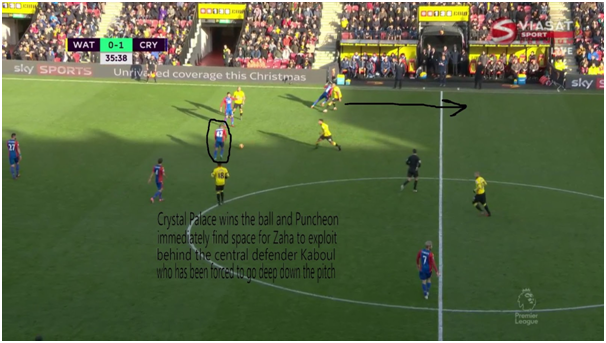
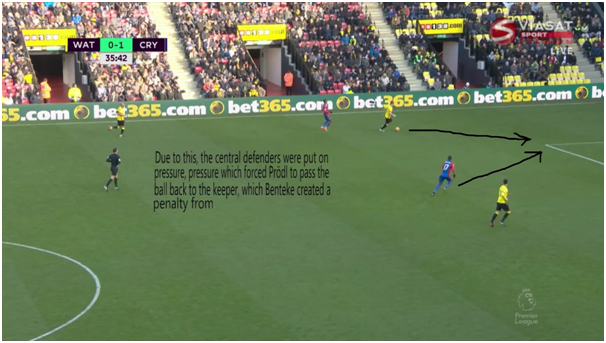
Mazzarri’s half time change that saved them a point
Although Crystal Palace had lots of chances to score 2-0 before half time like the penalty, they couldn’t finish them off, and went into their changing room only one goal ahead. After a whole half of this Crystal Palace dominance, Mazzarri had to make some changes, and he did. The Italian choose to go back into a 4-4-2 shape with Kaboul stepping out at right back, Britos and Prödl centrally, Holebas down at left, Amrabat on the right hand side and Zuniga on the left. Since Watford had to focus and prioritize their attacks, this was very necessary, because with this 4-4-2 shape, they could keep on putting pressure on Crystal Palace’s goal with their two heavy strikers up top in Ighalo and Deeney, and at the same time avoid numerical disadvantage on the flanks, push down the Crystal Palace wingers and therefore be more safe defensively.
On the other hand, this didn’t change much for Crystal Palace, more than they now had to hit harder on the counter, and therefore were forced to resist more pressure on their goal.
Below is an example of what it looked like when Watford defended on the flanks.
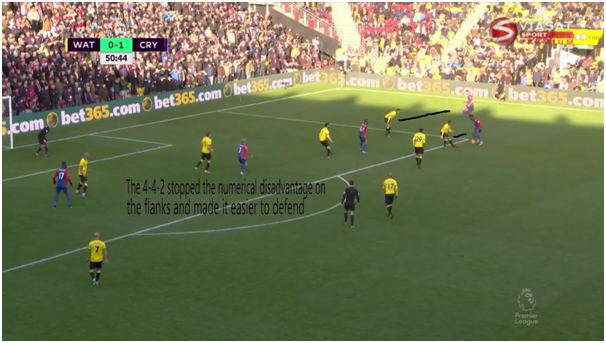
Conclusion
Although Sam Allardyce made a great tactical game Crystal Palace couldn’t pull of a win. Crystal Palace only scored one goal with their tactical advantage before half time, which proved to be too small a lead to hold on to for 45 minutes without any counter attacking threat forward. With that said Mazzarri’s tactical change at halftime where the Italian gave up on his three-man backline saved them a point, in a very rough game.
Although Sam Allardyce will surely regret the dropped two points, he should walk out of Vicarage Road satisfied, because the Englishman seems to have given Crystal Palace exactly what they needed in their bad league position, a new spark that could turn their season around.
Read all our tactical analyses here
- Tactical Analysis: Stoke City 1-2 Liverpool | Two crucial substitutes change the game - April 14, 2017
- Tactical Analysis: Middlesbrough 0-2 Manchester City | Doubts in Middlesbrough’s structures prove decisive - March 17, 2017
- Tactical Analysis: Southampton 0-5 Arsenal | Southampton get caught in a vicious circle - February 3, 2017


























































